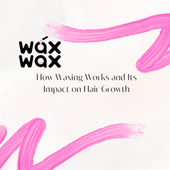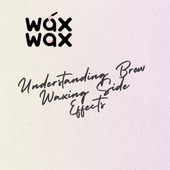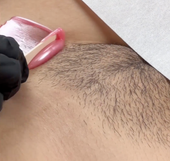Infected Ingrown Hair vs. Pimple: How to Tell the Difference
Deel
TL;DR: What Your Bump Is Telling You
Here’s the fast guide to identifying that mysterious red bump:
- Is it a Pimple? It's likely a standard pimple if it has a visible whitehead (clogged with oil/sebum) and no visible hair inside it.
- Is it an Ingrown Hair? It's likely an ingrown hair if it's a single, solid red bump and you can see a dark shadow or a small hair loop trapped just under the skin.
- Is it Folliculitis? It's likely folliculitis if it's not one big bump, but a cluster of small, itchy, uniform red or white-headed bumps that appear a few days after waxing, shaving, or hot tub use.
Hello WaxFam! Let's Identify That Bump
Hey, WaxFam. You got a wax, your skin was perfectly smooth, and then a few days later... a red bump appears. Or maybe it's a cluster of bumps. Or maybe it looks like a pimple. Your first instinct is to treat it, but what is it?
Before you reach for the pimple cream or (please don't!) the tweezers, you have to be a detective. Treating an ingrown hair like a pimple (or vice versa) won't work and can even make it worse.
At Wax Wax, we're the #1 specialist in hard wax for sensitive skin. We know that a pro-level result doesn't stop at the pull; it's about the total skin health that comes after. Using our gentle, Made in Italy hard wax is the best way to prevent irritation from the start. But for bumps caused by other issues, this guide is your first step to a solution. Knowing is half the battle.
The 3 Common Culprits: Pimple vs. Ingrown vs. Folliculitis
Let's break down the "usual suspects." While they can look similar, their cause is completely different.
1. The Pimple (Acne Vulgaris)
- What It Is: A classic pimple is a pore (follicle) that gets clogged with your skin's natural oils (sebum) and dead skin cells. Bacteria (specifically P. acnes) thrive in this environment, leading to an infection, a whitehead, and inflammation.
- What It Looks Like: A raised bump, often with a soft, white "head" of pus and oil. You will not see a hair trapped inside. It can be a single bump or can appear in groups.
- Primary Cause: Hormones, diet, stress, or skincare products. It's generally an internal oil production issue.
2. The Ingrown Hair
- What It Is: This is a mechanical problem, not a bacterial one (at first). It happens when a hair—usually one that's been cut or is growing back—can't find its way out of the follicle. It curls back and gets trapped, growing sideways or down. Your body then attacks this "invader," causing a red, inflamed bump.
- What It Looks Like: This is the key: it's almost always a single, solid, and often painful bump. You can usually see a dark shadow or a tiny loop of hair just beneath the surface. If it gets infected, it can look like a pimple, but the root cause is the trapped hair.
- Primary Cause: Dead skin blocking the follicle, friction from tight clothes, or improper hair removal (like shaving) that cuts the hair at a sharp angle.
3. Folliculitis
- What It Is: This is a bacterial or fungal infection of the hair follicles themselves. It's often caused by bacteria (like Staphylococcus aureus) or yeast entering the follicles, which are open and vulnerable after hair removal.
- What It LooksLike: This is the main difference. Folliculitis is rarely just one bump. It's almost always a cluster or rash-like patch of small, uniform red bumps or tiny whiteheads, each one centered on a hair follicle. It's often very itchy.
- Primary Cause: Damage to the follicle + bacteria. Common triggers include: shaving, friction from tight clothes, or sitting in a hot tub (which is a perfect breeding ground for bacteria).
The Bump Identification Chart
Use this simple chart to compare the "Big 3" side-by-side.
| Symptom | Pimple (Acne) | Ingrown Hair | Folliculitis |
|---|---|---|---|
| What It Is | Pore clogged with oil and bacteria. | A single hair trapped under the skin. | Infection of multiple hair follicles. |
| What It Looks Like | A whitehead. No hair is visible. | A single, solid bump. You can often see the hair. | A rash or cluster of small, uniform bumps. |
| Main Sensation | Tender, can be painful to press. | Painful, solid, and feels "deep." | Itchy and irritated. |
What to Do Next: How to Treat Each One
Now that you're a detective, you can pick the right solution.
- If it's a Pimple: Do NOT pick. Apply a standard acne spot treatment with benzoyl peroxide or salicylic acid. It should resolve on its own.
- If it's an Ingrown Hair: This is a mechanical problem. Our "Hub" article, How to Treat Ingrown Hair, has a 2-Phase Pro Guide on how to safely soothe it and (if possible) free the hair.
- If it's Folliculitis: This is an infection. Do NOT scrub or exfoliate it, as this will spread the bacteria. Keep the area clean and dry, and read our full guide on folliculitis after waxing for your next steps.
For a complete overview of all possible post-waxing issues, our esthetician's troubleshooting guide is your best resource.
What This Means for You
For our WaxFam (At-Home Users): The best "cure" for all of these is a good prevention routine. Using a home waxing kit with our hypoallergenic hard wax is the best first step. The second is a religious waxing aftercare routine. For ingrown hairs specifically, our Ingrown Hair Lotion is designed to keep follicles clear, while our Exfoliating Gloves clear the dead skin that traps hairs.
For our WaxFam Pro (Estheticians & Salon Owners): Being able to identify these three culprits is what makes you a pro. When a client calls with "bumps," you can ask them these exact questions (Is it one bump or a cluster? Can you see a hair?) to diagnose the problem. This builds incredible trust and gives you the authority to recommend the right retail product for them. Keep your salon stocked with aftercare solutions and wholesale wax beads to be the expert your clients rely on.
Frequently Asked Questions
Can an ingrown hair get infected and turn into a pimple?
Yes! This is very common. If you pick at an ingrown hair, you can introduce bacteria and turn a simple mechanical problem into an infected one. This is why our "Hub" guide is so strict about not digging.
Why do I get bumps after shaving but not waxing?
Shaving is the #1 cause of ingrown hairs, often called "razor bumps." It cuts the hair at a sharp, aggressive angle, making it easy for the hair to snag and grow back under the skin. Our guide on shaving vs. waxing breaks this down.
Can I wax over these bumps?
No. Never wax over any area that is broken, inflamed, or infected. This will be extremely painful and will spread the bacteria, making everything much worse. Wait until your skin is fully healed.
What if I have all three at once?
It's possible! If you're seeing a rash after waxing, it could be a mix of all three. The best solution is to be gentle. Stop all exfoliation, keep the area clean and dry, and let it heal.
When should I see a doctor or dermatologist?
If any bump is extremely painful, large and hard (like a cyst), or if a rashy area seems to be spreading or getting worse after 2-3 days, it's time to see a professional.
Our Final Word: Know Your Bump
So, WaxFam, don't just "treat" a bump—identify it.
Knowing what you're up against is the difference between making it worse and solving it fast. A pimple needs oil control. Folliculitis needs an antiseptic. And an ingrown hair needs a clear path. By correctly identifying the problem, you can finally apply the right solution and get back to the smooth, happy skin you deserve.
Related Posts
-
How to Properly Position Clients for Waxing: The Pro-Esthetician's Guide
TL;DR: For the Busy WaxFam Pro Here’s the high-level summary of professional positioning: It's Not Just Comfort, It...
-
What Is the Best Lotion for Preventing Ingrown Hairs? A Pro's Guide
TL;DR: The Pro-Grade Solution Here’s what to look for when you're shopping for the "best" lotion: It's a "Treatment...
-

How to Remove a Deep, Painful Ingrown Hair (Safely)
TL;DR: What to Do About a Deep Ingrown Hair Here's the short, safe answer for our WaxFam: STOP! Put the Tweezers Do...
-
How to Exfoliate to Prevent Ingrown Hairs (The Pro Guide)
TL;DR: The Pro-Exfoliation Method Here's the quick guide to stopping ingrown hairs before they start: Why Exfoliate...
-

Are Dyes in Hard Wax Safe? A Guide to Hypoallergenic Formulas
TL;DR: Are Dyes in Wax Safe? Here’s the short answer for our busy WaxFam: Not all dyes are bad, but low-quality, har...
-

The Real Secret to Waxing Salon Client Retention
TL;DR Client retention isn't just marketing; it's built into the core of your waxing service, starting with the pr...
-

The Ultimate Guide to Waxing Techniques
TL;DR Mastering waxing techniques means understanding more than just pulling hair. It’s about a holistic process: ch...
-

De gids voor het oplossen van problemen van de schoonheidsspecialist: Hoe u de 5 meest voorkomende huidreacties na het waxen kunt oplossen
TL;DR / Samenvatting Huidreacties na het waxen kunnen het vertrouwen van de klant en de winstgevendheid van de...
-

Hoe u effectief upsellt en cross-sellt van retailproducten in uw salon
TL;DR / Samenvatting Upselling en cross-selling van retailproducten in uw waxsalon kan de omzet en klanttevred...
-

De hoogste normen voor hygiëne en hygiëne voor een waxsalon
TL;DR / Samenvatting Het handhaven van de hoogste hygiëne- en hygiënenormen is onontbeerlijk voor waxsalons om...
-

De wetenschap van gevoeligheid: een diepgaande duik in de hypoallergene ingrediënten van WaxWax.com Hard Waxes
TL;DR / Samenvatting De veiligheid en tevredenheid van de klant staan voorop in een waxsalon. De keuze voor ...
-

Verplichte standaardwerkprocedures (SOP's) voor een moderne waxsalon
TL;DR / Samenvatting Het implementeren van robuuste standaardwerkprocedures (SOP's) is essentieel voor een mod...
-

Belangrijke overwegingen in een franchiseovereenkomst en openbaarmakingsdocument
TL;DR / Samenvatting Het starten van een waxfranchise en het starten van een waxbedrijf vereist een diepgaande...
-

Het benutten van sociale media (Instagram, TikTok) voor uw waxsalon
TL;DR / Samenvatting Socialemediaplatforms zoals Instagram en TikTok zijn krachtige tools voor waxsalons om kl...
-

Tips voor het werven, opleiden en behouden van professionele schoonheidsspecialisten
TL;DR / Samenvatting Het werven, opleiden en behouden van professionele schoonheidsspecialisten is cruciaal vo...
-

Een gids voor de bedrijfsvergunningen en licenties die nodig zijn om een salon te openen
Kortom Het openen van een waxsalon en franchise voor ontharing vereist het navigeren door een complex netwerk ...
-

Analyse van het winstpotentieel en de ROI van een schoonheidsfranchise
TL;DR / Samenvatting Investeren in een schoonheidssalonfranchise biedt een aanzienlijk winstpotentieel, maar h...
-

Top 10 veelgestelde vragen over franchisemogelijkheden voor waxen
TL;DR / Samenvatting Het onderzoeken van een franchisemogelijkheid voor waxing kan een 'game changer' zijn voor ...
-

Top 5 uitdagingen voor waxingbedrijven en hoe franchises de oplossing kunnen zijn
TL;DR / Samenvatting Bedrijven die zich bezighouden met waxen, kampen met grote uitdagingen die de winstgevendhe...
-

Een stapsgewijze handleiding voor het kiezen van een strategische locatie voor een waxsalon
TL;DR / Samenvatting Het kiezen van de perfecte locatie voor uw waxsalon is een belangrijke beslissing die het a...
-

Franchise versus onafhankelijke waxsalon: een analyse van de voor- en nadelen
TL;DR / Samenvatting Voor veel ondernemers is de keuze tussen een franchise of een onafhankelijke waxsalon een b...
-

Een volledig overzicht van de opstartkosten voor het openen van een waxsalon
TL;DR / Samenvatting Het openen van een waxsalon vereist een zorgvuldige financiële planning om winstgevendheid,...
-

De complete gids voor het starten van een franchisebedrijf in waxen voor franchisenemers (2025)
TL;DR / Samenvatting Het starten van een waxingfranchise in 2025 vereist een strategische aanpak om winstgevendh...
-

Calendula-thee: huidvoordelen van waxen: uw WaxFam-gids voor een gladde, verzachte huid
Hoi WaxFam, verzacht je huid met calendula! Hallo, WaxFam! Klaar om je waxervaring naar een hoger niveau te till...
-

Huidverzorgingsroutine voor een jeugdig decolleté van Wax Wax
Hey WaxFam, laten we je decolleté laten stralen! Hallo WaxFam! Klaar om je decolleté de sterrenbehandeling te ge...
-

Hoe kiest u de beste harde wax voor het waxen van uw wenkbrauwen?
Hey WaxFam, laten we die wenkbrauwen eens goed modelleren! Hoe gaat het, WaxFam? Klaar om je wenkbrauwen te perf...
-

Voorbereiding op het waxen van wenkbrauwen: tips voor een vlekkeloze ervaring
Hey WaxFam, maak je klaar voor perfecte wenkbrauwen! Wat is er goed, WaxFam? Klaar om je wenkbrauwen te modeller...
-

Nazorg na het harsen van de wenkbrauwen: verzacht en onderhoudt perfecte wenkbrauwen
Hey WaxFam, Laten we die wenkbrauwen in topvorm houden! Hallo WaxFam! Heb je je wenkbrauwen net laten waxen en voe...
-

Veelvoorkomende fouten bij het waxen van wenkbrauwen (en hoe u deze kunt vermijden met harde wax)
Hey WaxFam, laten we die wenkbrauwen in topvorm brengen! Welkom, WaxFam, bij jouw ultieme gids voor het p...
-

Mag je douchen na het waxen? Jouw WaxFam-gids voor verzorging na het waxen
Hoe gaat het, WaxFam? Vers gewaxt en je fantastisch voelen? Bij Wax Wax doen we er alles aan om je de gladste huid ...
-

Kun je je laten waxen tijdens je menstruatie? Jouw WaxFam-gids voor een soepele zelfverzekerdheid
Hallo WaxFam! Of je je nu voorbereidt op een dagje strand of gewoon verlangt naar een gladde huid, Wax Wax beantwoo...
-

Vertraagt waxen de haargroei? De waarheid onthuld voor WaxFam
Welkom, WaxFam, bij een nieuwe duik in de wereld van een gladde, stralende huid! Bij Wax Wax draait alles om het le...
-

Wenkbrauwen waxen voor mannen: bijwerkingen aanpakken met de harde waxoplossingen van WaxWax
Hoi WaxFam, laten we het hebben over wenkbrauwen waxen voor mannen! Welkom bij de WaxWax-familie, waar we er all...
-

Infecties na het waxen? Zo voorkom en behandel je ze op natuurlijke wijze met WaxWax.
Hey WaxFam! Laten we het hebben over infecties na het waxen (en hoe je ze kunt voorkomen) We snappen het, WaxFam...
-

Pigmentveranderingen na het waxen: oorzaken, oplossingen en hoe WaxWax uw huid redt
Hey WaxFam, laten we stralen zonder pigmentatieproblemen! Hoe gaat het, WaxFam? Klaar om die gladde, haarvrije g...
-

Ernstige huidbeschadiging na het waxen: bijwerkingen, oplossingen en hoe WaxWax je dag redt
Hey WaxFam, laten we het hebben over de problemen en successen van het waxen! Welkom bij de WaxWax-sfeer, waar e...
-

Allergische en immuunreacties bij het waxen: uw gids voor een veilige, gladde huid met WaxWax
Hey WaxFam, zeg vaarwel tegen waxproblemen met WaxWax! Welkom bij de WaxWax-sfeer, waar een gladde huid en een s...
-

Folliculitis na het waxen: oorzaken, preventie en behandeling voor een gladde, stralende huid
WaxFam, we snappen het – niets is beter dan de zijdezachte, langdurige resultaten van een verse wax. Maar die verve...
-

Navigeren door de regelgeving voor harde was in Canada: een gids voor WaxFam voor 2025
Hé WaxFam! Of je nu een professionele schoonheidsspecialiste bent die klanten perfect waxt of een thuisgebruiker di...
-

Harde was voor de gevoelige huid: de beste keuzes aanbevolen door Canadese dermatologen
Hé WaxFam! Een gevoelige huid kan een ware strijd zijn in het extreme klimaat van Canada, waar ijzige winters en vo...
-

Milieuvriendelijke harde was in Canada: duurzame schoonheid voor bewuste consumenten
Hé WaxFam! Canadezen lopen voorop in de strijd voor groene schoonheid, en milieuvriendelijke, veganistische hardwax...
-

De ultieme gids voor het hele jaar door waxen voor Canadezen: feiten, tips en seizoensstrategieën
Hé WaxFam! Een gladde huid is niet alleen voor de zomer – het hele jaar door waxen zorgt ervoor dat je straalt, zel...
-

Winterharsen in Canada: de beste harde waxkeuzes voor een droge, gevoelige huid
Hé WaxFam! De Canadese winters zijn meedogenloos – ijzige wind, temperaturen onder het vriespunt en droge binnenwar...
-

Waxen voor vrouwen: trends, gegevens en inzichten
Hey WaxFam, welkom bij jouw ultieme gids over waxen voor vrouwen! Waxen is een populaire ontharingsmethode voor vro...
-

Wat u niet moet doen vóór een Braziliaanse wax
Hallo WaxFam! Welkom bij een nieuwe duik in de wereld van soepel, zelfverzekerd en zorgeloos waxen met Wax Wax – jo...
-

Waarom wordt een braziliaanse wax een braziliaanse wax genoemd?
Hallo WaxFam! Welkom bij weer een diepgaande verkenning van Wax Wax, hét merk voor alles op het gebied van ontharin...
-

Nabehandeling van het waxen – Essentiële tips voor een gladde, gelukkige huid
Hé WaxFam! Of je nu een ervaren waxer bent die thuis je waxvaardigheden onder de knie probeert te krijgen of ee...
-

Hollywood Wax – Uw complete gids voor een zijdezachte finish
Hallo WaxFam! Welkom terug bij een nieuwe blog boordevol kennis van Wax Wax, het merk dat zich toelegt op het berei...
-

Alternatieven voor wasmachines – Nieuwe manieren om was te smelten
Hallo WaxFam! Welkom bij een nieuwe diepgaande blog van Wax Wax, jouw vertrouwde partner in de wereld van zijdezach...














































